Haryana State Board HBSE 9th Class Maths Solutions Chapter 10 Circles Ex 10.4 Textbook Exercise Questions and Answers.
Haryana Board 9th Class Maths Solutions Chapter 10 Circles Exercise 10.4
Question 1.
Two circles of radii 5 cm and 3 cm intersect at two points and the distance between their centres is 4 cm. Find the length of the common chord.
Solution:
Let AB be the common chord of the two circles having their centres at O and O’, then
OO’ = 4 cm, OA = 5 cm and AO’ = 3 cm
we have 52 = 42 + 32
⇒ 25 = 16 + 9
⇒ 25 = 25
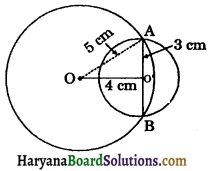
Therefore, OA is the hypotenuse and AO’O is the right triangle right angled at O’.
Now, OO’ ⊥ AB
AO’ = O’B = \(\frac{1}{2}\)AB [By theorem 10.3]
⇒ 3 = \(\frac{1}{2}\)AB
⇒ AB = 6 cm
Hence, AB = 6 cm.
![]()
Question 2.
If two equal chords of a circle intersect within the circle, prove that the segments of one chord are equal to corresponding segments of the other chord.
Solution:
Given: AB and CD are two equal chords of a circle C(O, r). AB and CD intersect at P.
To prove : (i) BP = DP, (ii) AP = CP.

Construction: Draw OM ⊥ AB and ON ⊥ CD and join OP.
Proof: Since, OM ⊥ AB
∴ AM = MB = \(\frac{1}{2}\)AB ……(i)
and ON ⊥ CD
∴ CN = ND = \(\frac{1}{2}\)CD …….(ii)
AB = CD (given) ……(iii)
From (i), (ii) and (iii), we get
AM = CN
and MB = ND …..(iv)
In right ΔOMP and ΔONP, we have
∠OMP = ∠ONP [Each is 90°]
Hyp. OP= Hyp. OP (Common)
OM = ON
[∵ Equal chords of a circle are equidistant from the centre]
∴ ΔOMP ≅ ΔΟΝΡ [By RHS congruence rule]
⇒ PM = PN (CPCT) …(v)
Adding (iv) and (v), we get
MB + PM = ND + PN
⇒ BP= PD
Subtracting (v) from (iv), we get
AM – PM = CN – PN
⇒ AP = CP
Hence, BP = PD and AP = CP.
Proved
Question 3.
If two equal chords of a circle intersect within the circle, prove that the line joining the point of intersection to the centre makes equal angles with the chords.
Solution:
Given: AB and CD are two equal chords of a circle with centre O.
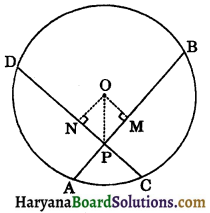
To prove : ∠OPM = ∠OPN.
Construction : Draw OM ⊥ AB and ON ⊥ CD and join OP.
Proof: In right ΔOMP and ΔONP, we have
∠OMP = ∠ONP [Each is 90°]
Hyp. OP = Hyp. OP (Common)
OM = ON [∵ Equal chords are equidistant from the centre]
∴ ΔΟΜΡ ≅ ΔΟΝΡ [By RHS congruence rule]
∠OPM ≅ ∠OPN (CPCT)
Hence proved
![]()
Question 4.
If a line intersects two concentric circles (circles with the same centre) with centre O at A, B, C and D, prove that AB = CD
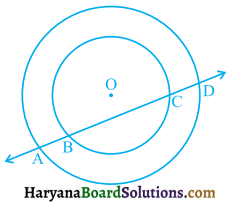
Solution:
Draw OM ⊥ AD.
Now, AD is a chord of larger circle and OM ⊥ AD.
∴ AM = MD
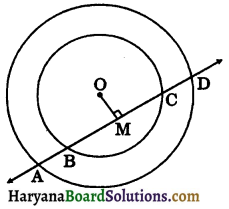
Again BC is a chord of smaller circle and ОM ⊥ ВС.
∴ BM = MC …… (ii)
Subtracting (ii) from (i), we get
AM – BM = MD – MC
⇒ AB = CD.
Hence proved
Question 5.
Three girls Reshma, Salma and Mandip are playing a game by standing on a circle of radius 5 m drawn in a park. Reshma throws a ball to Salma, Salma to Mandip, Mandip to Reshma. If the distance between Reshma and Salma and between Salma and Mandip is 6 m each, what is the distance between Reshma and Mandip?
Solution:
Let the position of Reshma, Salma and Mandip be at R, S and M respectively on the circumference of the circular park.
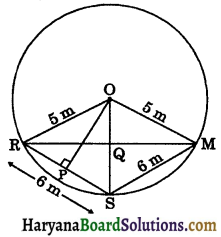
∴ RS = SM = 6 m
Draw OP ⊥ RS
∴ RP = PS = \(\frac{1}{2}\)RS
RP = \(\frac{1}{2}\) × 6 = 3 m
In right ΔOPR, we have
OR2 = RP2 + OP2
⇒ 52 = 32 + OP2
⇒ OP2 = 52 – 32
⇒ OP2 = (5 + 3) (5 – 3)
⇒ OP2 = 8 × 2 = 16
⇒ OP = \(\sqrt{16}\) = \(\sqrt{4 \times 4}\) = 4 m
Area of ΔORS = \(\frac{1}{2}\) × RS × OP
⇒ Area of ΔORS = \(\frac{1}{2}\) × 6 × 4 = 12 m2…(i)
In ΔROS and ΔMOS, we have
RO = MO [Radii of a same circle]
RS = SM [Each is equal to 6 m]
OS = OS (Common)
∴ ΔROS ≅ ΔMOS (By SSS congruence rule)
⇒ ∠ROS = ∠MOS (CPCT)
⇒ ∠ROQ = ∠MOQ …….(ii)
Now, in ΔOQR and ΔOQM, we have
OR = OM [Radii of a same circle]
∠ROQ = ∠MOQ [As proved above in (ii)]
OQ = OQ (Common)
∴ ΔOQR ≅ ΔOQM (By SAS congruence rule)
⇒ ∠OQR = ∠OQM (CPCT) …(iii)
But ∠OQR + ∠OQM = 180° (By linear pair axiom)
⇒ ∠OQR + ∠OQR = 180° [Using (ii)]
⇒ 2∠OQR = 180°
⇒ ∠OQR = \(\frac{180^{\circ}}{2}\) = 90°
∴ RQ ⊥ OS
Again,area of ΔORS = \(\frac{1}{2}\) × OS × RQ
⇒ 12 = \(\frac{1}{2}\) × 5 × RQ
⇒ \(\frac{12 \times 2}{5}\) = RQ
⇒ RQ = 4.8 m
OQ ⊥ RM and RM is a chord.
∴ RQ = \(\frac{1}{2}\)RM (By theorem 10.3)
⇒ 4.8 = \(\frac{1}{2}\)RM
RM = 4.8 × 2 = 9.6 m
Hence, the distance between Reshma and Mandip = 9.6 m
![]()
Question 6.
A circular park of radius 20 m is situated in a colony. Three boys Ankur, Syed and David are sitting at equal distance on its boundary each having a toy telephone in his hands to talk each other. Find the length of the string of each phone.
Solution:
Let position of Ankur, Syed and David be A, S and D respectively at the boundary of circular park.
Since, three boys are sitting at equal distance at boundary of circular park.

∴ \(\widehat{A S}=\widehat{S D}=\widehat{A D}\)
⇒ chord AS = chord SD = chord AD
⇒ ASD is an equilateral triangle.
We know that centroid of an equilateral ΔASD concides with its circumcentre i.e., centroid of ΔASD is O and radius of circle is 20 m
⇒ SO = DO = AO = 20 m
Since, centroid divides the median in the ratio 2 : 1.
Therefore, AO : OP = 2 : 1
⇒ \(\frac{A O}{O P}=\frac{2}{1}\)
⇒ \(\frac{20}{O P}=\frac{2}{1}\)
⇒ OP = \(\frac{20}{2}\) = 10 m
In right ΔOPS, we have
OS2 = OP2 + SP2 (By Pythagoras theorem)
⇒ 202 = 102 + SP2
⇒ SP2 = 202 – 102
⇒ SP2 = (20 + 10) (20 – 10)
⇒ SP2 = 30 × 10
⇒ SP = \(\sqrt{30 \times 10}\) = \(\sqrt{3 \times 10 \times 10}\)
SP = 10\(\sqrt{3}\) m
We know that in an equilateral triangle, median is perpendicular to corresponding side of the triangle. Therefore AP ⊥ SD.
Now OP ⊥ SD and SD is a chord.
∴ SP = \(\frac{1}{2}\)SD
10\(\sqrt{3}\) = \(\frac{1}{2}\)SD
SD = 20\(\sqrt{3}\) m
Hence, length of each string of phone is 20\(\sqrt{3}\) m.
Alter: Let AS = SD = AD = x m
In right ΔAPS, we have
AS2 = SP2 + AP2 (By Pythagoras theorem)
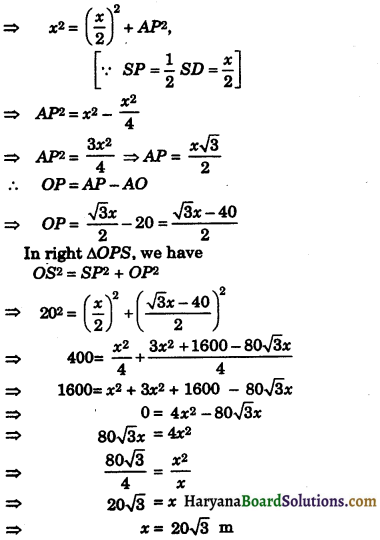
Hence, length of each string of phone is 20\(\sqrt{3}\) m.